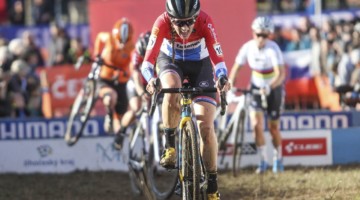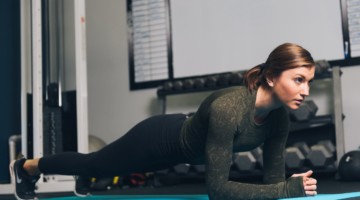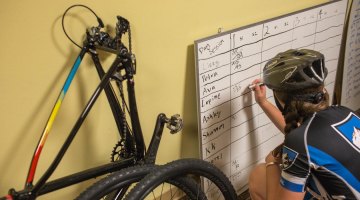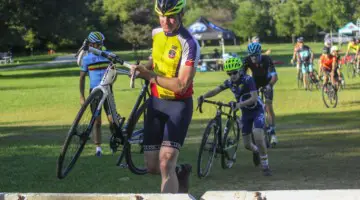by Josh Schwiesow
We recently discussed losing weight and counting calories here in the noob corner of Cyclocross Magazine. It was satisfying to me that this column generated some discussion, if not below in the comments section or in the Cowbell Forums, but rather through some personal correspondence with me – which I encourage as well! The goal of the noob section is interactive learning.
I don’t want to give the impression that all I did was a little math and then simply cut calories. In fact, part of what inspired such a behavioral change was yet another book, the Feed Zone Cookbook. Earlier this year, when it was still winter, I had a cycling buddy tell me about this great book, only to have one of our track coaches mention that he loved the book as well. Not being one for cooking, I basically filed the information away without much thought.
A few weeks later my cycling club had their beginning-of-the-year meeting where rules, goals, kits, races, and volunteer opportunities were discussed and time was set aside for one of the book’s authors. What was stressed was that this book was truly written for us – the young adult cyclist without much time or cooking experience, and who likely doesn’t eat well. [To see a video of Lim discussing the principles in his book, click here.]
I decided to give this a try for several reasons. The first was that there were no shortage of highly influential testimonials on the ease and taste of these meals. (Note: I’m recommending this book without any personal gain – I just really like it.) Perhaps more importantly was the focus on healthy ingredients and a nutritional breakdown with every recipe, which fit seamlessly into the plan I previously discussed regarding tracking calories in and out using the training peaks software. Lastly, Chef Biju and Dr. Lim really promote eating sport foods prepared at home rather than always relying on sport bars, gels, and elixirs.
My wife was highly skeptical, as I didn’t do much cooking and when I did was known for pretty much only making hamburgers or occasional spaghetti. Although I have invented my own recipe using ramen noodles and foil-pouch tuna, it was not popular amongst friends and family. But as advertised, the recipes were easy and healthy – even when creating dressing from scratch, and I began cooking one or two nights per week. My favorites include the Sweet Rice Porridge, the Strawberry Chicken Salad, Simple Biryani, and the Seared Ahi Tuna. Very interesting is their combination recipe where you make beet juice and then use the pulp for veggie burgers, although a juicer is required. The beet juice is a bit of an acquired taste, but overall this is a recipe I now enjoy.
From here, I actually began reading more and more about nutrition, and it was an occasional topic of discussion with other cycling or triathlete friends. I began to branch into other cookbooks and was pleased to find that there are many references out there with both recipes as well as nutritional profiles and with a little experience, my cooking got even better.
One of the things I had promised to do in my first Cyclocross Magazine column was consult an expert when possible and necessary. I was wondering how I might do this when a triathlete friend and coworker suggested a really good registered dietician he was working with, Jacque Maldonado. Curiously, I had seen her name when flipping through the list of local coaches on the training peaks website with a cyclocross listing in her profile, and so I soon emailed her.
Jacque actually does not race cyclocross, although we cannot hold that against her as she has a B.S. and M.S. in Nutrition and is an avid endurance athlete having finished several full Ironman® Triathlons and over 25 marathons including qualifying for Boston. Needless to say, she knows her stuff and fits every definition of the expert I was looking for. After a few emails and phone calls back and forth, I made an appointment to see her.
One of the things Jacque likes to do for her athletes is a “resting metabolic rate” using MedGem® Indirect Calorimeter, in order to determine daily calorie needs. This is a device you breathe into for several minutes wearing a nose-plug. Prior to the morning test, no food, coffee, or exercise was allowed, only water.
The test wasn’t difficult, although at times I felt as though my breathing was shallow and short. Curiously and predictably, what the device suggested my resting metabolic rate approximated was similar (within 100 calories) to that predicted by the Harris-Benedict and the Mifflin-St. Jeor equations. In other words, if you don’t have access to this sort of test, the math will get you plenty close. Above this, because I have a desk-based job, Jacque felt it was appropriate to multiply my RMR by 1.2 for an “off-day” calorie burn estimate and then separately add in exercise (much like Matt Fitzgerald suggested). After some discussion of workout habits, she gave me some parameters for increased caloric requirements based on one hour, two hours, three hours, et cetera, of exercise. In my case, two hours of hard workout basically doubled my caloric needs for the day!
I had previously discussed how I was tracking calories in – that is fairly straightforward. Trickier are the calories burned during exercise, and I’d already played with various web-based calculators where you input your vitals, workout type, and speed, and the output is estimated calories. What is frustrating is that these rarely matched the calories burned provided by Garmin devices. The Garmin bike computer I use is notoriously “optimistic” on calories burned to the point where my friends and I have routinely taken to multiplying their estimate by anywhere from 0.4 – 0.6 to get a better estimate. The Garmin running watch I use seems far more accurate to Jacque’s estimates and to the various running calculators out there on the web. These tools plus Jacque’s estimates give me a decent target for daily intake based on what the day holds for activity.
The next discussion we had was making better food choices. In my particular case as a cancer survivor, Jacque had sent a document from the American Institute for Cancer Research on reducing risk by moving to a more plant-based diet, and she gave me several meal tips and suggestions. We also discussed protein requirements. While controversial, most athletes consume more than necessary Additionally, much like Chef Thomas and Dr. Lim, Jacque agreed with the philosophy of making your own sport foods and relying less on pre-packaged items.
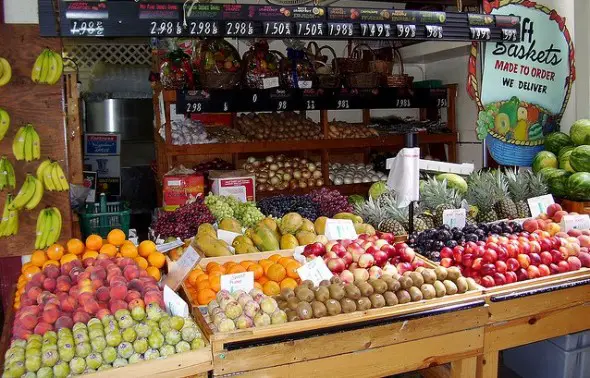
A local farmer's market can provide a bounty that boosts performance and reduces cancer risk. © lachshand on flickr
A few specific suggestions to share include what not to eat before exercise. While it seems obvious, high fat and high fiber foods should be avoided, as should meat, doughnuts, fries, chips, and candy bars. What to eat before depends on how much time before the event. For example, if you only have 30 minutes, a sport drink or gel is probably all you can handle. However, I like to eat two hours before any race, personally, and in that case my standard pre-race breakfast of granola and milk, juice, and fruit for 400-600 calories/160g of carb works. If you have four hours, a bigger meal of rice, chicken, and vegetables at 1000–1500 calories would work, depending on the length and intensity of the exercise.
One of the last hanging questions I had was how to best handle the dramatic drop in weight I had. The answer wasn’t simply more protein, but rather slightly more all-purpose calories as a whole, combined with the similar workload. In other words, it wasn’t a license to pig-out, but rather to add a few hundred extra calories here and there and regain the strength over time.
In all, a visit to an expert as well as discussion with similar athletes and an unbelievable amount of reading material has been tremendously helpful to me. I can’t help but think it may help racing this fall, but even if my results are no better, I have decreased some cancer risk and subjectively feel better through better food choices.
Here’s the Noob Hand-Up:
- Even a total noob can cook healthy, delicious meals with the right resources and ingredients.
- Mathematical equations are not a bad approximation for resting metabolic rate in the absence of a physiologic test.
- Estimating caloric burn is more difficult but possible with some experience, fudge factors, and comparison of several methods and calculators.
- Making healthier choices does not sacrifice taste! (Opposite in my experience so far, in fact)
- Pre-packaged energy bars and gels are not the only option for nutrition during exercise.
- A Sports Nutritionist / Registered Dietician with personal, specific recommendations is well worth the consult!
























